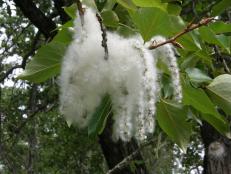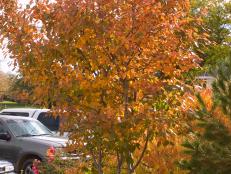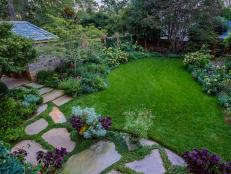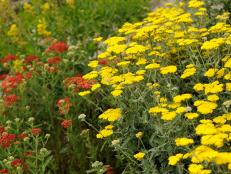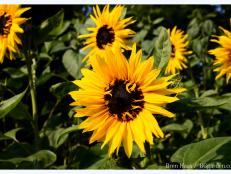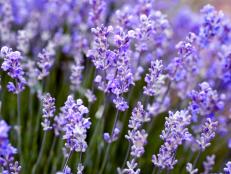Drought Resistant Landscaping Ideas
Learn what to consider in designing and planting a water-wise garden that fits your yard's environment.

Scott Nuss
In an area prone to drought, a dry river bed made of pebbles and stones is wise and so darn pretty.

Water is a precious and limited resource that all living things depend on, including plants. Traditional gardens and lawns can guzzle water, but they don’t have to. Simply taking the time to understand your local environment and your garden’s needs, making good choices when it comes to plants and irrigation and being flexible in the face of change can help create colorful gardens that conserve essential water.
It's easy to take water for granted — especially outdoors in the garden. Clean and inexpensive water is available straight from the tap virtually whenever we want it. While it can be tough for us to recognize just how much water our landscapes use on an individual level, the data is shocking. EPA statistics show that about 30% of residential water is dedicated to outdoor use, but those figures can be as high as 60% in arid regions like the Southwest. Even more staggering is that as much as 50% of all outdoor irrigation is wasted, lost to evaporation, wind or runoff.
What is Drought-Tolerant Landscaping?
While traditional dry landscape gardens heavy in rock and desert-loving succulents are beautiful, they aren’t the only option for water-savvy gardeners. Fortunately for gardeners, there are a number of ways to create a functional, well-tended garden while still being mindful of water usage. Learning more about your garden, choosing appropriate plants and using best practices for maintenance will allow any gardener to create a vibrant and even verdant garden that conserves water.
Below are five ways to plan and create a water-wise garden.
1. Know Your Garden
No single article or book can tell you exactly what will work best for your garden. In fact, some of the conditions in your garden are unique to your property. Learning more about the particular conditions in your region and in your landscape will help you make good choices when it comes to finding gorgeous garden plants that will thrive without added water.
Your Regional Environment
Why should a drought resistant garden in Florida look different than another in Arizona or Connecticut? The environment in each of those areas varies drastically, with wildly different precipitation, temperatures and wind conditions. Understanding the climatic trends in your area is the first step to water-smart gardening.
Rainfall is the main source of water for water-wise gardens. Plants across the globe have adapted to thrive in their native environment’s unique natural weather conditions. Understanding how much rain, on average, you can expect in your area and identifying rainy seasons will help you find plants that are best suited to grow without the need for supplemental irrigation.
Temperature also plays a role in water-wise gardening. As a general rule of thumb, when temperatures rise, so do plants’ water needs. The USDA Plant Hardiness Zone Map and the American Horticulture Society’s Heat Zone Map can help you get a sense of the minimum and maximum temperatures you can expect in your area. However, it’s also important to know when and for how long to expect warm and cool weather too.
For a more detailed picture of your region’s climatic conditions, you can punch your zip code in the National Weather Service website to see the 30-year averages for precipitation or temperatures in your area, broken down by month. These are valuable resources, not only to learn how much rain you can expect (on average) and identify high and low temperatures, but also to pinpoint seasonal averages.
Wind can impact the water needs of your garden. When windy weather dries out the air around plant foliage, species from humid environments will need to absorb more water to cope. A well-placed hedge, fence or windbreak can protect plants from desiccating winds. Check with your local extension service to learn if drying winds can be a problem in your area.
Your Garden Environment
While it helps to learn some characteristics for your area, the plants in your garden will also have to thrive in conditions that are unique to your property, including soil, sunlight and topography.
Soil can vary in terms of texture and quality, which can impact how well it can retain water and how easily plant roots can draw moisture from it. Sandy soils drain freely and need to be amended with organic matter (such as compost or aged manure) to hold moisture longer. Clay soils hold water tightly for long periods, but plant roots can have trouble drawing moisture from clay during extended dry periods. A dose of organic material can break up tight clay soils. If Goldilocks did soil testing, silty soils would be “just right” because they retain water better than sandy soils but share water with plants better than clay.
The best way to find out the proportion of sand, silt, clay and organic matter in your soil is to do a soil test. Most state extension services have labs that can perform soil tests on samples sent in from gardeners and will provide detailed reports that include soil texture, nutrient content and the level of acidity or alkalinity. Once you know the type of soil in your garden, you can choose plants that have adapted to thrive in your existing soil conditions with minimal or absolutely no modifications.
Sunlight can impact how much water plants use. Typically, the sunnier the conditions, the more water a plant will need to grow. Of course, some plants have adapted to thrive in full sun, while others perform best in the shade. Check outside in the morning, afternoon and evening to get a sense of how much sunlight each area of your garden gets. It’s a good idea to take a few quick photos at different times of day that you can refer to later.
Site Topography affects plant exposure to wind and sunlight and how stormwater moves across the landscape. Gardens planted on south or west facing sites tend to warm up earlier in the season, be more exposed to sunlight during the day, and soils may dry out more quickly. On the other hand, north or east facing gardens tend to stay cooler, have more moderate temperatures and require less water.
Every drop of rainwater counts in a water-wise garden and none can afford to be lost to the stormwater system. The next time it rains, watch how water flows across your landscape. If rainwater rapidly moves off your property into the street or stormwater drains, consider how you could capture and hold that water, allowing it to infiltrate into the soil on your property. Rain gardens, check dams, swales, berms and dry creek beds are just a few ways you can slow, direct, and hold rainwater.
2. Choose Your Plants
Now that you know more about your garden’s environment, it’s time to think about the plants that will perform best given your landscape’s precipitation, temperatures, wind conditions, soil, sunlight availability and topography.
Drought resistant planting is not “one size fits all,” and appropriate plant palettes for water-wise gardens will vary wildly depending on where you are gardening. For example, a common lilac (Syringia vulgaris) may be an appropriate choice for gardeners in New England, but the same species will need supplemental irrigation to survive in the South. On the other hand, many succulent cacti thrive in the heat of the American Southwest, but will need sharply drained soils to perform well in regions that have more ample rainfall. Finding the right plant for the right place in your garden will result in landscapes that are resilient and attractive.
Find Inspiration in Local Gardens
One of the best ways to find plants that will perform well in your area is to see what other gardeners are growing. Many public gardens across the country include examples of xeriscape and sustainable gardens. If a plant draws your eye, but you’re not sure if the area is irrigated or if the plant would be a good fit for your landscape, most botanic gardens have knowledgeable staff who are happy to answer any questions. You can also explore private gardens on Open Garden Days in search of inspiration. Your local extension service may have recommendations for drought resistant plants that thrive in your area.
Let Nature be Your Teacher
Drought-Tolerant Plants for Dry Soil 20 Photos
These pretty flowers and plants grow naturally in dry environments.
Plants that are native to your area have adapted to thrive in the same sort of conditions that can be found in your garden. Take a nature hike to explore natural plant communities that grow in an environment similar to your landscape. Remember to consider how topography, sunlight and soil may differ between your property and the natural area. Don’t collect plants or seeds from the wild. Many native species are available from local garden centers and specialty online nurseries. If you need help identifying plants from your nature walk, simply upload photos of the plants you’re interested in to a user-friendly application like iNaturalist for help.
Study Your Current Landscape
Creating a water-wise garden doesn’t necessarily mean the existing garden should be scrapped. What plants are doing well without the need for irrigation? Which plants are water hogs? Try scaling back watering for the more demanding plants to learn how little water they can actually get by with.
In many areas of the country, traditional lawns require about an inch of sprinkler irrigation a week. That’s a lot of water! While it's hard to beat turfgrass for outdoor sports and recreation, there may be areas of your garden where lawn isn’t necessary. Make a dent in your irrigation needs by replacing all or part of your lawn with water-wise alternatives.
13 Great Low-Water Plants 13 Photos
Discover plants that deliver outstanding landscape color without guzzling water.
- Areas with heavy foot traffic could be swapped with crushed gravel or permeable pavers for an attractive walkway or seating area.
- Spaces less travelled could be replaced by new water-wise garden beds or sustainable “lawn” with plants that mimic turf in appearance, like sedges (Carex spp.) or buffalograss (Buchloe dactyloides).
- A last option would be to cut back on watering the lawn while raising the mowing height. In temperate regions, conventional warm-season grasses, like Bermuda grass and zoysia, don’t die without summer watering. They simply go dormant, greening up when rains return later in the season. Increasing the mowing height will help turf establish stronger root systems that are more tolerant of dry weather.
Think Beyond the Boxes
3. Plant Smart
Putting plants in the ground is one of the most fun parts of gardening! However, it can be easy to get carried away. Pause a moment to choose the plants that will perform best in the long term and wait to plant them at the optimal time of year.
Start Small
When it comes to planting, bigger is not always better. Nurseries pamper container-grown plants, which can have trouble getting established in the garden. In their book Planting in a Post-Wild World, authors Thomas Rainer and Claudia West write, “The truth is, plants that grow and interact with a given soil from an early age are often the most long lasting, healthy and resilient.” Smaller plants can also colonize the soil more quickly, cutting down on watering needs during establishment. What does this mean for gardeners?
Consider starting herbaceous plants from seed, divisions or cuttings and woody trees and shrubs from bare root plants. More specialty nurseries, like Prairie Moon Nursery, now offer plug trays that historically have only been available in the wholesale trade. Container-grown plants are still the best option for instant gratification for slower growing plants — just be sure to remove excess potting soil before planting. When planting trees and shrubs, remember to remove circling roots, plant at the correct depth and water well.
Timing is Everything
The best time to plant is when temperatures are moderate and rainwater is plentiful — usually in spring or fall. Why? Plants grown under these conditions are able to anchor in and establish roots more easily than during the heat of summer or winter dormancy. Check with your local extension service to learn when the best time of year to plant in your area is.
4. Follow Best Practices
Editing your existing garden layout to be more in tune with the local environment and adding new, drought resistant plants are two important steps for curbing water consumption. The last piece of the puzzle is to use sound maintenance practices that will make plants more resilient to dry conditions and help soils retain water.
Water Deeply and Infrequently
The Proper Way to Water Your Garden
Keep your plants happy. Here are the top 10 do's and don’ts for watering plants efficiently.
All plants need water to live and your new drought resistant plants are no exception. Depending on the species, you’ll need to keep an eye on water for the first season at a minimum. While it’s tempting to set up the sprinkler and walk away, there are better, more water efficient ways to irrigate.
Plants absorb water from the soil through their roots, and plants are smart — their roots almost always grow where there is moisture. When a drought hits, the top layer of soil dries out first, which means that deep-rooted plants are more resistant against withering weather. To train your plants to develop deep roots, make sure that your irrigation water is going into the soil rather than running off to the side. If you’re watering by hand, add a little water at a time, pausing until all the moisture has soaked into the earth before pouring more. Slow the flow with a soaker hose or drip irrigation system. Use a timer to avoid wasting water, and water plants before 10 a.m. to limit water lost to evaporation.
Use a rain gauge to measure just how much rainwater hits the garden and hold off on watering if Mother Nature already did it for you. If you want to be sure there’s enough moisture in the soil, check with a soil probe or moisture meter.
Use Mulch
In most areas of the country, a healthy layer of a plant-based mulch like wood chips, shredded autumn leaves or pine straw is a great way to conserve water while building organic matter in the soil. Depending on the circumstances and the type of mulch used, between 1 and 3 inches of mulch prevents water loss to evaporation, feeds soil organisms that improve soil structure and limits weed competition.
Gardeners in naturally dry, rocky areas like the Southwest may find that gravel mulch is a better choice for their gardens. Gravel mulch minimizes evaporation and is a good choice around succulent or fuzzy plants that are adapted to dry environments. However, gravel mulches are much less effective at preventing weed growth in cooler, moist areas, and they don’t improve soil organic matter.
Only Fertilize if There's a Deficiency
Using fertilizers in moderation can be great when water isn’t a limiting factor. Unfortunately, excess nutrients in a garden bed can limit plants’ ability to easily absorb water from the soil. The good news is that many drought-resistant plants seem to grow best without added fertilizer and can actually become more loose and leggy when fertilized. If you notice nutrient deficiency symptoms on a plant, reach out to your local extension service for help with a plant tissue analysis to find out if there is a fertility issue.
5. Be Flexible
One of the most important lessons for water-mindful gardeners is to be open to change. Any form of gardening is an experiment and your garden may need to be edited as it grows. Some plants may need to be replaced, garden beds may need to be reoriented and so on. The possibility of change and the opportunity to improve are part of what makes gardening so fun!

.-Battle-on-the-Beach-courtesy-of-HGTV.-.jpg.rend.hgtvcom.196.196.suffix/1714761529029.jpeg)





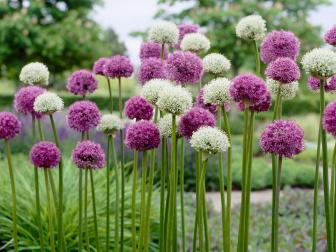


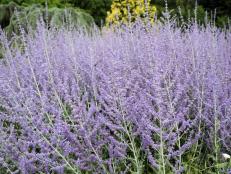
.jpg.rend.hgtvcom.231.174.suffix/1716908436155.jpeg)
